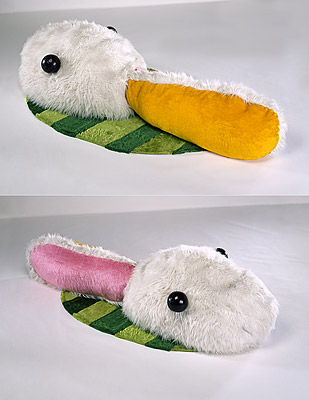Kathy
TEMIN
Australia
1968
Duck-rabbit problem
1991
synthetic fur, synthetic stuffing, wood, polystyrene ball, enamel paint
52.5 (h)
x 187.8 (w)
x 124.0 (d)
cm
National Gallery of Victoria, Melbourne
Purchased through The Art Foundation of Victoria with the assistance of the Rudy Komon Fund, Governor, 1998 98.282.A–C
Image courtesy of the artist
Kathy Temin’s flaccid, furry sculpture is at once appealing and repellent. Synthetic fur seems an amusing, if somewhat trivial, approach to the famous problem of double perception. Duck–rabbit problem1991 is based upon an image drawn from Ludwig Wittgenstein’s Philosophical investigations 1953, later reproduced in EH Gombrich’s Art and illusion 1960. Temin’s sculpture physically embodies the question presented by this ambiguous image. Is it a duck? Is it a rabbit? In fact it is either, but can never be both simultaneously. The work playfully re-emphasises, through its own fluffy, deflated presence, the integral links established by the ‘duck/rabbit’, between perception, cognition and seeing.
Temin remains unwilling either to search for or provide answers to the ‘problem’ posited by the sculpture’s title. Instead she allows the uncomfortable, indeterminate position of her work (with deliberate references to high and low culture, good and bad taste) to highlight its difference to the process-driven, problem-solving concerns of her modernist forbears. Deliberately irreverent and anti-authoritarian, Temin’s decidedly feminine objects also defy the gestalt experience of modernist sculpture through their soft, floppy and rounded forms and use of garish colour. As the artist has stated: ‘I have been interested in reworking minimalism so it takes on the appearance of what it represses―the body, sentiment and memory.’[1]
The fuzzy ‘animal’ seen here has a wonky, hand-made quality. It happily combines associations of childhood comfort, and it toys with the overt materiality of work by artists such as Meret Oppenheim, Eva Hesse, Claes Oldenburg and Joseph Beuys. The splayed vulnerability of Duck–rabbit problem explores connections between the historical investigations of Minimalism and Arte Povera and brings the more intimate concerns of domesticity and craft, the emotional and the personal, into the public space of the gallery. It also further heightens the duality, the push/pull power of Temin’s sculptural object (want to touch/don't want to touch), through the circulation of competing issues and concerns. There is no sense of closure in working out this issue.
Kelly Gellatly
Curator, Contemporary Art
National Gallery of Victoria, Melbourne
[1] Kathy Temin in conversation with Pricilla Pitts, September 1995, in Priscilla Pitts, ‘Materiality and metamorphosis: Kathy Temin in New Plymouth’, Kathy Temin: wall drawings, objects and videos: made in New Plymouth 1995, Govett-Brewster Art Gallery, New Plymouth, 1995, p 3

